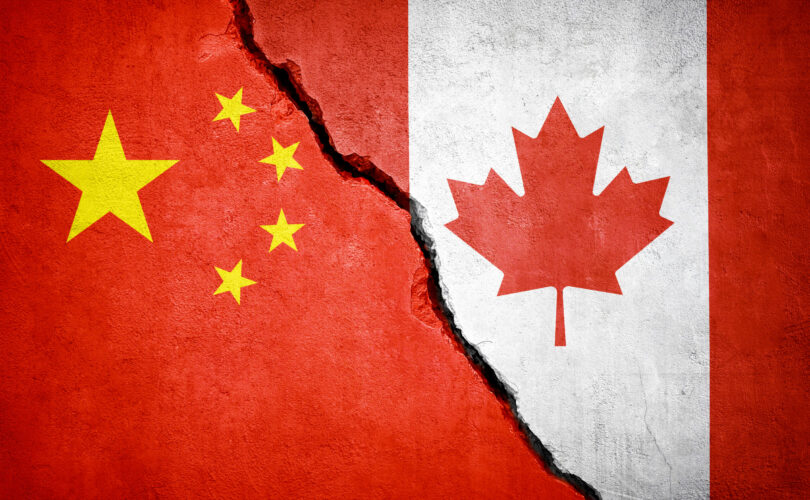Business
Declining Canadian dollar could stifle productivity growth in Canada

From the Fraser Institute
By Steven Globerman and Lawrence Schembri
The Bank of Canada’s decision last week to lower its policy rate by 50 basis points increases the gap between the U.S. Federal Reserve’s policy rate and the Bank of Canada’s rate to approximately 130 basis points. While this gap might close somewhat if the Federal Reserve lowers its rate at its meeting this week, a substantial U.S. premium will still exist.
Since borrowing rates are tied to policy rates, interest rates in Canada will remain well below those in the U.S. for the foreseeable future. This gap will continue to put downward pressure on the value of the Canadian dollar against the U.S. greenback, as investors favour higher-earning U.S. dollar-denominated assets over Canadian dollar assets. President-elect Trump’s threatened trade actions against Canada could also exert further downward pressure on the loonie, especially if the Bank of Canada responds to Trump’s actions by making additional rate cuts. For context, it took $1.33 Canadian dollars to purchase one U.S. dollar on January 1, 2024, compared to $1.43 Canadian dollars on December 13, 2024. This represents a substantial depreciation in the Canadian dollar’s value of approximately 7.6 per cent over the period.
What effects will a declining Canadian dollar have on the Canadian economy?
In short, it will increase demand for domestic output and labour and put upward pressure on inflation via higher import prices, and it could also lower productivity growth and further hurt living standards.
Why the impact on productivity?
Because Canada imports most of its machinery and equipment (including information and communications technology) from the U.S. and other countries, and investment in this type of physical capital helps drive productivity growth. A declining Canadian dollar makes capital equipment imports more expensive, thereby discouraging investment and slowing productivity growth. A declining Canadian dollar may also shelter domestic firms from foreign competition, which could dampen their incentive to invest in productivity-enhancing assets, even if they price their output in U.S. dollars.
Hence, if the Canadian dollar remains weak against the U.S. dollar and other currencies, it may be more difficult to reverse Canada’s productivity woes. Again, productivity—the amount of GDP per hour of labour the economy produces—is key to improving living standards, which have been on the decline in Canada. From July to September of 2024, the economy grew by 0.3 per cent yet per-person GDP (an indicator of living standards) fell by 0.4 per cent (after adjusting for inflation).
Canada also indirectly imports technology via direct investments made by U.S.-based companies in their Canadian subsidiaries. While a declining Canadian dollar makes it cheaper for U.S. companies to buy assets in Canada, it also reduces the U.S. dollar value of profits earned over time in Canada by American-owned companies. This phenomenon, combined with an unstable Canadian dollar, might discourage inward foreign direct investment and associated technology transfers by increasing the financial uncertainty of such investment.
To be clear, this is not a criticism of the Bank of Canada’s move last week to help lower domestic interest rates given the Bank’s primary mandate to meet its inflation rate target of 2 per cent. Rather, governments—including the Trudeau government—must enact policies to encourage business investment in productivity-enhancing assets.
For starters, policymakers should reduce business tax rates and the tax rate on capital gains, to encourage innovation and entrepreneurship. They should also dramatically reduce the regulatory burden and other barriers to entry and growth, especially those faced by small and medium-sized businesses. And the federal and provincial governments should increase competition in the domestic economy by reducing interprovincial trade barriers.
For example, the provinces could adopt a policy of “mutual recognition” so the standards and licencing requirements in one province would be accepted by all provinces. Provinces can also unilaterally eliminate self-imposed trade barriers (as Alberta did in 2019 with grazing permits for livestock). Of course, due to resistance from special interest groups that benefit from internal barriers, such reforms will not be easy. But the economic risks to the Canadian economy—from even the threat of a trade war with the U.S.—could generate support among Canadians for these reforms. Indeed, reducing interprovincial barriers to trade and labour mobility might be the single most important thing that governments in Canada could do to improve productivity.
With Canada’s lower inflation rate, weaker labour market and weaker economic growth outlook compared to the U.S., lower interest rates in Canada seem appropriate. Bank of Canada Governor Tiff Macklem wants to see economic activity pick up to absorb slack in the economy and prevent inflation settling below the bank’s 2 per cent target. Clearly, the Bank should focus on inflation and domestic economic conditions. But policymakers must do their part to create a better environment for investment and innovation, the keys to productivity and increased living standards for Canadians.
Business
Feds pull the plug on small business grants to Minnesota after massive fraud reports

The Small Business Administration is moving to freeze grant money flowing into Minnesota after explosive allegations of large-scale fraud tied to state oversight failures, with SBA Administrator Kelly Loeffler signaling an immediate crackdown following recent independent reporting.
In a series of comments shared publicly by conservative commentator Benny Johnson, Loeffler said the agency is “cutting off and clawing back” SBA grants to the state while investigators dig deeper into what she described as a rapidly expanding fraud network.
Johnson wrote that Loeffler told him she was “disgusted and sickened” after reviewing footage from YouTuber Nick Shirley, whose on-the-ground reporting in Minnesota highlighted what he said were sham daycare and learning centers collecting millions in public funds despite showing little or no sign of legitimate operations.
According to Johnson, Loeffler blamed the situation on Democrat Gov. Tim Walz, accusing his administration of refusing to enforce basic rules governing small businesses and allowing fraud to flourish unchecked.
Johnson said Loeffler told him SBA investigators were able to identify roughly half a billion dollars in suspected fraud within days of focusing on Minnesota, calling the operation an “industrial-scale crime ring” that ripped off American taxpayers.
“Pending further review, SBA is freezing all grant funding to the state in order to stop the rampant waste of taxpayer dollars and uncover the full depth of fraud,” Loeffler said, according to Johnson’s account, adding that the total scope of the scheme remains unknown and could reach into the billions.
The controversy gained national traction after Shirley posted video of himself visiting multiple facilities, including a South Minneapolis site known as the Quality Learning Center, which he reported was approved for federal aid for up to 99 children but appeared inactive during normal business hours.
The center’s sign, Shirley noted, even misspelled the word “learning” as “learing.”
In the footage, a woman inside the building is heard shouting “Don’t open up,” falsely claiming Shirley and his colleague were Immigration and Customs Enforcement agents.
After the video circulated, Rep. Tom Emmer, a Republican, publicly demanded answers from Walz, questioning how such facilities were approved for millions in taxpayer funding.
Shirley’s reporting followed earlier investigations, including a November report by City Journal alleging that members of Minnesota’s Somali community had sent millions of dollars in stolen taxpayer funds overseas, with some of that money reportedly ending up in the hands of Al-Shabaab, a U.S.-designated terrorist organization.
While Walz’s administration has insisted it takes fraud seriously, the SBA’s decision to halt grant funding marks one of the most aggressive federal responses yet, underscoring how rapidly a local scandal has escalated into a national reckoning over oversight, enforcement, and accountability in Minnesota.
Business
Stripped and shipped: Patel pushes denaturalization, deportation in Minnesota fraud

FBI Director Kash Patel issued a blunt warning over the weekend as federal investigators continue unraveling a sprawling fraud operation centered in Minnesota, saying the hundreds of millions already uncovered represent “just the tip of a very large iceberg.”
In a lengthy statement posted to social media, Patel said the Federal Bureau of Investigation had quietly surged agents and investigative resources into the state well before the scandal gained traction online. That effort, he said, led to the takedown of an estimated $250 million fraud scheme that stole federal food aid intended for vulnerable children during the COVID pandemic.
According to Patel, the investigation exposed a network of sham vendors, shell companies, and large-scale money laundering operations tied to the Feeding Our Future case. Defendants named by the FBI include Abdiwahab Ahmed Mohamud, Ahmed Ali, Hussein Farah, Abdullahe Nur Jesow, Asha Farhan Hassan, Ousman Camara, and Abdirashid Bixi Dool, each charged with offenses ranging from wire fraud to conspiracy and money laundering.
Patel also said Abdimajid Mohamed Nur and others were charged in a separate attempt to bribe a juror with $120,000 in cash. He noted that several related cases have already resulted in guilty pleas, prison sentences of up to 10 years, and nearly $48 million in restitution orders.
Despite those outcomes, Patel warned the case is far from finished.
“The FBI believes this is just the tip of a very large iceberg,” he said, adding that investigators will continue following the money and that the probe remains ongoing. Patel further confirmed that many of those convicted are being referred to immigration authorities for possible denaturalization and deportation proceedings where legally applicable.
The renewed focus follows a viral video circulated by independent journalist Nick Shirley, which appeared to show multiple childcare and learning centers operating as empty or nonfunctional storefronts. The footage sparked immediate backlash from Republicans, including Vice President JD Vance.
House Majority Whip Tom Emmer accused Minnesota Gov. Tim Walz of sitting idle while massive sums were stolen from taxpayers. Walz addressed the allegations during a November press conference, before the full scope of the fraud became public, saying the scandal “undermines trust in government” and threatens programs meant to help vulnerable residents.
“If you’re committing fraud, no matter where you come from or what you believe, you are going to go to jail,” Walz said at the time.
Authorities say the alleged schemes date back to at least 2015, beginning with overbilling Minnesota’s Child Care Assistance Program and later expanding into Medicaid-funded disability and housing programs. One such housing initiative, aimed at helping seniors and disabled residents secure stable housing, was shut down earlier this year after officials cited what they described as large-scale fraud.
The fallout has already reached the federal level. Last month, President Trump announced the suspension of Temporary Protected Status for Somali nationals, arguing that Minnesota had become a hub for organized welfare fraud and money laundering activity.
-

 Digital ID1 day ago
Digital ID1 day agoCanadian government launches trial version of digital ID for certain licenses, permits
-

 Alberta1 day ago
Alberta1 day agoAlberta Next Panel calls to reform how Canada works
-

 International1 day ago
International1 day agoGeorgia county admits illegally certifying 315k ballots in 2020 presidential election
-

 Agriculture2 days ago
Agriculture2 days agoEnd Supply Management—For the Sake of Canadian Consumers
-

 Business1 day ago
Business1 day agoThe “Disruptor-in-Chief” places Canada in the crosshairs
-

 Artificial Intelligence1 day ago
Artificial Intelligence1 day agoUK Police Pilot AI System to Track “Suspicious” Driver Journeys
-

 Energy1 day ago
Energy1 day ago‘The electric story is over’
-

 International1 day ago
International1 day agoWorld-leading biochemist debunks evolutionary theory








